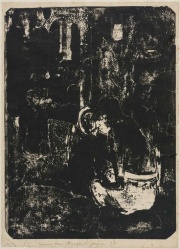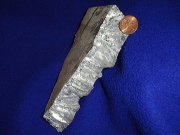Difference between revisions of "Zinc"
(username removed) |
|||
| (7 intermediate revisions by 5 users not shown) | |||
| Line 1: | Line 1: | ||
| − | [[File:2001.703-SC20650.jpg|thumb|]] | + | [[File:2001.703-SC20650.jpg|thumb|Zincograph<br>MFA# 2001.703]] |
== Description == | == Description == | ||
| + | [[File:2004.131-SC109088.jpg|thumb|Print from Zinc plate<br>MFA# 2004.131]] | ||
| + | A bluish-white, lustrous metallic element. Zinc occurs with an abundance of 0.02% in the earth's crust in the minerals [[smithsonite]] (ZnCO3), [[sphalerite]] (ZnS), [[zincite]], [[willemite]], and [[gahnite]]. Zinc was discovered in prehistoric times and it was first isolated from the ores in India in the 13th century by the reduction of [[calamine]]. China was mass producing zinc by the 16th century. In Europe, commercial production began after techniques for its isolation were discovered by Andreas Sigismund Marggraf in Germany in 1746. The present major mining producers are : China, Peru, Australia, United sates, Canada, India, Kazakhstan, Bolivia, Mexico, Ireland. The malleable metal is ductile at 150 C, but becomes so brittle at 180 C that it can be powdered. It is most commonly used as an anti-corrosive galvanized coating for other metals. Metallic zinc is also used in alloys, such as [[brass]], to increase workability. [[Zinc oxide|Zinc oxides]] are used in artists pigments, photocopiers, sunscreens, and antiseptic ointments. [[Zinc sulfide|Zinc sulfides]] are used as phosphors in cathode ray tubes. Zinc containing pigments include [[zinc white]], [[zinc yellow]], and [[lithopone]]. | ||
| − | |||
| − | |||
| − | |||
== Synonyms and Related Terms == | == Synonyms and Related Terms == | ||
| + | [[File:ZincMetalemr1.jpg|thumb|Metallic zinc]] | ||
| + | Zn; merrillite; Zink (Ned., Deut., Sven.); zinc (Fr;); zinco (It., Port.); cinc (Esp.) | ||
| + | == Risks == | ||
| − | + | * Powdered zinc is highly flammable and produces toxic fumes when burned. | |
| − | + | * ThermoFisher: [https://www.fishersci.com/store/msds?partNumber=AC222600025&productDescription=ZINC%2C+GRANULAR%2C+20+MESH+2.5KG&vendorId=VN00032119&countryCode=US&language=en SDS Zinc powder] | |
| − | == | + | * Tech Resources: https://www.teck.com/media/Zinc-Metal-SDS.pdf SDS zinc metal] |
| − | + | == Physical and Chemical Properties == | |
| − | Burns in air with a bluish green flame. | + | * Reacts slowly with ammonia, water, acetic acid, sulfuric acid, or hydrochloric acid. |
| + | * Readily reacts with nitric acid and alkali hydroxides. | ||
| + | * Burns in air with a bluish green flame. | ||
{| class="wikitable" | {| class="wikitable" | ||
| Line 27: | Line 31: | ||
|- | |- | ||
! scope="row"| Melting Point | ! scope="row"| Melting Point | ||
| − | | 419.5 | + | | 419.5 C |
|- | |- | ||
! scope="row"| Density | ! scope="row"| Density | ||
| − | | 7.14 | + | | 7.14 g/ml |
|- | |- | ||
! scope="row"| Molecular Weight | ! scope="row"| Molecular Weight | ||
| Line 36: | Line 40: | ||
|- | |- | ||
! scope="row"| Boiling Point | ! scope="row"| Boiling Point | ||
| − | | 908 | + | | 908 C |
|} | |} | ||
| − | + | ==Resources and Citations== | |
| − | == | ||
| − | |||
| − | |||
| − | |||
| − | |||
| − | |||
| − | |||
| − | |||
| − | |||
| − | |||
| − | |||
| − | |||
| − | |||
| − | |||
| − | |||
| + | * Web Elements: [http://www.webelements.com/webelements/elements/text/H/key.html Website] | ||
| + | * Richard S. Lewis, ''Hawley's Condensed Chemical Dictionary'', Van Nostrand Reinhold, New York, 10th ed., 1993 | ||
| + | * Random House, ''Webster's Encyclopedic Unabridged Dictionary of the English Language'', Grammercy Book, New York, 1997 | ||
* ''The Merck Index'', Martha Windholz (ed.), Merck Research Labs, Rahway NJ, 10th edition, 1983 Comment: entry 10255 | * ''The Merck Index'', Martha Windholz (ed.), Merck Research Labs, Rahway NJ, 10th edition, 1983 Comment: entry 10255 | ||
| − | + | * ''Encyclopedia Britannica'', http://www.britannica.com Comment: "Zinc." Accessed 19 May 2004. | |
| − | * ''Encyclopedia Britannica'', http://www.britannica.com Comment: "Zinc." | ||
| − | |||
* ''Chemical & Engineering News'', American Chemical Society, Washington DC, 81 (36) , Sept. 8, 2003 Comment: Ronald Breslow, p. 86: discovery in Europe by Andreas Marggraf in 1746 | * ''Chemical & Engineering News'', American Chemical Society, Washington DC, 81 (36) , Sept. 8, 2003 Comment: Ronald Breslow, p. 86: discovery in Europe by Andreas Marggraf in 1746 | ||
| + | * Wikipedia: [https://en.wikipedia.org/wiki/Zinc Zinc] Accessed Oct. 2024) | ||
| − | + | [[Category:Materials database]][[Category:MWG]][[Category:Metal]] | |
| − | [[Category:Materials database]] | ||
Latest revision as of 11:12, 3 October 2024
Description
A bluish-white, lustrous metallic element. Zinc occurs with an abundance of 0.02% in the earth's crust in the minerals Smithsonite (ZnCO3), Sphalerite (ZnS), Zincite, Willemite, and Gahnite. Zinc was discovered in prehistoric times and it was first isolated from the ores in India in the 13th century by the reduction of Calamine. China was mass producing zinc by the 16th century. In Europe, commercial production began after techniques for its isolation were discovered by Andreas Sigismund Marggraf in Germany in 1746. The present major mining producers are : China, Peru, Australia, United sates, Canada, India, Kazakhstan, Bolivia, Mexico, Ireland. The malleable metal is ductile at 150 C, but becomes so brittle at 180 C that it can be powdered. It is most commonly used as an anti-corrosive galvanized coating for other metals. Metallic zinc is also used in alloys, such as Brass, to increase workability. Zinc oxides are used in artists pigments, photocopiers, sunscreens, and antiseptic ointments. Zinc sulfides are used as phosphors in cathode ray tubes. Zinc containing pigments include Zinc white, Zinc yellow, and Lithopone.
Synonyms and Related Terms
Zn; merrillite; Zink (Ned., Deut., Sven.); zinc (Fr;); zinco (It., Port.); cinc (Esp.)
Risks
- Powdered zinc is highly flammable and produces toxic fumes when burned.
- ThermoFisher: SDS Zinc powder
- Tech Resources: https://www.teck.com/media/Zinc-Metal-SDS.pdf SDS zinc metal]
Physical and Chemical Properties
- Reacts slowly with ammonia, water, acetic acid, sulfuric acid, or hydrochloric acid.
- Readily reacts with nitric acid and alkali hydroxides.
- Burns in air with a bluish green flame.
| Composition | Zn (atomic no. = 30) |
|---|---|
| CAS | 7440-66-6 |
| Mohs Hardness | 2.5 |
| Melting Point | 419.5 C |
| Density | 7.14 g/ml |
| Molecular Weight | at. wt. = 65.38 |
| Boiling Point | 908 C |
Resources and Citations
- Web Elements: Website
- Richard S. Lewis, Hawley's Condensed Chemical Dictionary, Van Nostrand Reinhold, New York, 10th ed., 1993
- Random House, Webster's Encyclopedic Unabridged Dictionary of the English Language, Grammercy Book, New York, 1997
- The Merck Index, Martha Windholz (ed.), Merck Research Labs, Rahway NJ, 10th edition, 1983 Comment: entry 10255
- Encyclopedia Britannica, http://www.britannica.com Comment: "Zinc." Accessed 19 May 2004.
- Chemical & Engineering News, American Chemical Society, Washington DC, 81 (36) , Sept. 8, 2003 Comment: Ronald Breslow, p. 86: discovery in Europe by Andreas Marggraf in 1746
- Wikipedia: Zinc Accessed Oct. 2024)


